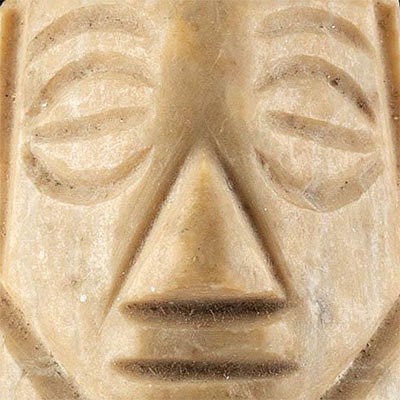5 Colima Obsidian Pectorals and 117 Shell Beads
Lot 59
About Seller
Artemis Gallery
686 S Taylor Ave, Ste 106
Louisville, CO 80027
United States
Selling antiquities, ancient and ethnographic art online since 1993, Artemis Gallery specializes in Classical Antiquities (Egyptian, Greek, Roman, Near Eastern), Asian, Pre-Columbian, African / Tribal / Oceanographic art. Our extensive inventory includes pottery, stone, metal, wood, glass and textil...Read more
Estimate:
$1,000 - $1,500
Absentee vs Live bid
Two ways to bid:
- Leave a max absentee bid and the platform will bid on your behalf up to your maximum bid during the live auction.
- Bid live during the auction and your bids will be submitted real-time to the auctioneer.
Bid Increments
| Price | Bid Increment |
|---|---|
| $0 | $25 |
| $300 | $50 |
| $1,000 | $100 |
| $2,000 | $250 |
| $5,000 | $500 |
| $10,000 | $1,000 |
| $20,000 | $2,500 |
| $50,000 | $5,000 |
| $100,000 | $10,000 |
| $200,000 | $20,000 |
About Auction
By Artemis Gallery
Jun 3, 2021
Set Reminder
2021-06-03 12:00:00
2021-06-03 12:00:00
America/New_York
Bidsquare
Bidsquare : It's a Small World | Diminutive Artifacts
https://www.bidsquare.com/auctions/artemis-gallery/its-a-small-world-diminutive-artifacts-7031
Join us for a very special auction featuring art & artifacts from East to West, North to South, and everywhere in between - with one small thing in common - size! Everything in this auction is approximately 6 inches or less - perfect for that last bit of shelf space in your curio cabinet! Artemis Gallery info@artemisgallery.com
Join us for a very special auction featuring art & artifacts from East to West, North to South, and everywhere in between - with one small thing in common - size! Everything in this auction is approximately 6 inches or less - perfect for that last bit of shelf space in your curio cabinet! Artemis Gallery info@artemisgallery.com
- Lot Description
Pre-Columbian, West Mexico, Colima, ca. 300 BCE to 300 CE. A magnificent ensemble of 117 hand-carved white shell beads and 5 hand-knapped obsidian pectoral pendants/beads. Boasting a lustrous surface, all of the shell beads present discoid bodies with central annular drill holes. Alternatively, each pectoral is rendered in a curved shape perhaps intended to conjure lunar crescents, with perforations at either end for suspension. Obsidian carvings were coveted offerings found in Colima tombs. Colima, located on Mexico's southwestern coast, was part of the shaft tomb tradition, along with neighbors to the north in Jalisco and Nayarit. In this culture, the deceased were interred in shafts, approximately 3 to 20 meters deep, that were dug vertically or near vertically through the volcanic tuff that makes up the geology of the region. The base of the shaft would open into one or more horizontal chambers with low ceilings. These shafts were almost always dug beneath a dwelling, probably a family home, and scholars posit that they were likely used as family mausoleums, housing the remains of many related individuals. Size of largest pectoral: 5.625" L x 0.375" W (14.3 cm x 1 cm); Size of shell beads (all about the same): 0.25" in diameter (0.6 cm); Size of frame: 18.75" L x 12.75" W (47.6 cm x 32.4 cm)
Obsidian - "iztli" to them - fascinated the ancient Mesoamericans; the Aztecs even had a god, Tezcatlipoca, who was the Lord of the Smoking Obsidian Mirror; indeed obsidian was used to create mirrors as well. Furthermore, in a world without metal, obsidian's ability to be sharp was also especially important for ceremonies of ritual bloodletting and human sacrifice. The difficult-to-obtain material came from volcanic sources in the Sierra Madre of Mexico and in Guatemala, was traded hundreds of miles to meet the demand for sharp cutting tools and ritual objects, and then was struck using a deer antler or small hammer stones to form blades and coveted forms like these.
Provenance: private Fayetteville, Arkansas, USA collection; ex-Dr. David Harner collection, Springdale, Arkansas, USA, acquired between the 1950s and 1960s
All items legal to buy/sell under U.S. Statute covering cultural patrimony Code 2600, CHAPTER 14, and are guaranteed to be as described or your money back.
A Certificate of Authenticity will accompany all winning bids.
We ship worldwide and handle all shipping in-house for your convenience.
#163567Nicks to peripheries of all items commensurate with knapping process, with light abrasions and encrustations to faces. Otherwise, intact and excellent. Great surface smoothness throughout.Condition
- Shipping Info
-
All shipping is handled in-house for your convenience. Your invoice from Artemis Gallery will include shipping calculation instructions. If in doubt, please inquire BEFORE bidding for estimated shipping costs for individual items.
-
- Buyer's Premium



 EUR
EUR CAD
CAD AUD
AUD GBP
GBP MXN
MXN HKD
HKD CNY
CNY MYR
MYR SEK
SEK SGD
SGD CHF
CHF THB
THB












